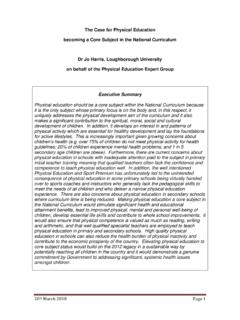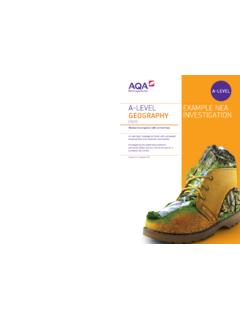Transcription of National Geographic Geography Handbook
1 Geography HandbookGH1 Geography HandbookGH1 Saharan sanddunes, Morocco The Gui River,Guilin, China The Amazon, Brazil The story of the world begins with geog-raphy the study of the earth in all of itsvariety. Geography describes the earth sland, water, and plant and animal life. It isthe study of places and the complex relationships between people and theirenvironment. The resources in this Handbook will helpyou get the most out of your textbook andprovide you with skills you will use for therest of your (t)Dallas and John Heaton/CORBIS, (c)Jamie Harron/CORBIS, (b)Owen Franken/CORBISGH1-GH15 FM-GeoHb-824133 3/29/04 12:03 AM Page GH1GH2 Geography HandbookPlaces and RegionsPlacehas a special mean-ing in Geography .
2 It meansmore than where a place also describes what a placeis like. It might describephysical characteristics suchas landforms, climate, andplant or animal life. Or itmight describe human characteristics, including language and way of help organize theirstudy, geographers oftengroup places into united by one or more common understand how our world is connected,some geographers have broken down the studyof Geography into five themes. The Five Themesof Geographyare (1) location, (2) place, (3)human/environment interaction, (4) movement,and (5) regions. You will see these themes high-lighted in the Chapter Assessment GeographySkills of Journey Across Time: The Early Essential ElementsRecently, geographers have begun to look atgeography in a different way.
3 They break downthe study of Geography into Six aware of these elements willhelp you sort out what you are learning World in Spatial TermsGeographers first take a look atwhere a place is located. Locationserves as a starting point by asking Where is it? Knowing the loca-tion of places helps youdevelop an awareness ofthe world around SystemsWhen studying placesand regions, geographersanalyze how physicalsystems such as hurri-canes, volcanoes, andglaciers shape theearth s surface. They alsolook at communities ofplants and animals thatdepend upon one anotherand their surroundingsfor HandbookGetty Images GH1-GH15 FM-GeoHb-824133 3/29/04 12:06 AM Page GH2 Geography HandbookGH3 Environment and SocietyHow does the relation-ship between people andtheir natural surroundingsinfluence the way peoplelive?
4 This is one of the questions that the theme of human/environmentinteractioninvestigates . It also shows how people use the environment andhow their actions affect the SystemsGeographers also examinehuman systems,or howpeople have shaped ourworld. They look at howboundary lines are deter-mined and analyze whypeople settle in certainplaces and not in others. Akey theme in Geography isthe continual movementofpeople, ideas, and Uses of GeographyKnowledge of geographyhelps us understand therelationships among people ,places, and environmentsover time. Understandinggeography and knowinghow to use the tools andtechnology available tostudy it prepares you for life in our modern HandbookGH3 Geography HandbookGetty Images GH1-GH15 FM-GeoHb-824133 3/29/04 12:08 AM Page GH3GH4 Geography HandbookHemispheresTo locate a place on the earth, geographersuse a system of imaginary lines that crisscrossthe globe.
5 One of these lines, the Equator,cir-cles the middle of the earth like a belt. Itdivides the earth into half spheres, or north of the Equator is inthe Northern Hemisphere. Everything south of the Equator is in the Southern imaginary line runs from north tosouth. It helps divide the earth into halfspheres in the other direction. Find this line called the Prime Meridianon a east of the Prime Meridian for 180 degrees is in the Eastern west of the Prime Meridian is inthe Western HandbookNorthern HemisphereNorth PoleSouth PoleAsiaAsiaNorthAmericaNorthAmericaSout hAmericaSouthAmericaPacificOceanPacificO ceanPacificOceanIndianOceanIndianOceanAn tarcticaAtlanticOceanAtlanticOceanAtlant icOceanAustraliaAustraliaEuropeEuropeAfr icaAfricaAfricaSouthern HemisphereWestern HemisphereEastern HemisphereHemispheresGH1-GH15 FM-GeoHb-824133 3/17/05 11:08 AM Page GH4 LatitudeLines of latitude, or parallels,circle theearth parallel to the Equatorand measurethe distance north or south of the Equatorin degrees.
6 The Equator is at 0 latitude,while the North Pole lies at latitude 90 N(north).LongitudeLines of longitude, or meridians,circle the earthfrom Pole to Pole. These lines measure distances eastor west of the starting line, which is at 0 longitudeand is called the Prime PrimeMeridian runs through the Royal Observatory inGreenwich, England. Lines on globes and maps provide informationthat can help you easily locate places on theearth. These lines called latitudeandlongitude cross one another, forming a patterncalled a grid LocationThe grid system formed by lines of latitude andlongitude makes it possible to find the absolutelocation of a place. Only one place can be foundat the point where a specific line of latitudecrosses a specific line of longitude.
7 By usingdegrees ( ) and minutes (') (points betweendegrees), people can pinpoint the precise spotwhere one line of latitude crosses one line of longitude an absolute HandbookGH5GH1-GH15 FM-GeoHb-824133 3/29/04 12:14 AM Page GH5GH6 Geography HandbookThe most accurate way to depict the earth is as aglobe, a round scale model of the earth. A globegives a true picture of the continents relative sizesand the shapes of landmasses and bodies of accurately represent distance and mapis a flat drawing of all or part of theearth s surface. Unlike globes, maps can show smallareas in great detail. Maps can also display politicalboundaries, population densities, or even Globes to MapsMaps, however, do have their limitations.
8 Asyou can imagine, drawing a round object on aflat surface is very difficult. Cartographers,ormapmakers, use mathematical formulas totransfer information from the round globe to a flat map. However, when the curves of aglobe become straight lines on a map, the size, shape, distance, or area can change or be Circle RoutesMapmakers have solved some problems ofgoing from a globe to a map. Agreat circleisan imaginary line that follows the curve of theearth. Traveling along a great circle is calledfollowing a great circle pilotsuse great circle routes because they are theshortest idea of a great circle shows one impor-tant difference between a globe and a a globe is round, it accurately showsgreat circles. On a flat map, however, the greatcircle route between two points may not appearto be the shortest distance.
9 Compare Maps Aand B on the With TechnologyTechnology has changed the way maps aremade. Most cartographers use software pro-grams called Geographic information systems(GIS).This software layers map data fromsatellite images, printed text, and statistics. AGlobal Positioning System (GPS)helps con-sumers and mapmakers locate places based oncoordinates broadcast by Handbook60 N30 N30 S0 120 E180 120 WPACIFICOCEANMap ALosAngelesTokyoEWNSTrue Direction Distance5,795 mi. (9,324 km)Great Circle Distance5,450 mi. (8,769 km)Mercator projection3,0003,0000 kmMap BPACIFICOCEAN60 N40 N180 120 W60 W0 60 E120 EGreat Circle RouteLosAngelesTokyoNorth PoleEWNSP olar Gnomonic projection3,0003,0000 kmTrueDirectionRouteGreat Circle RouteGH1-GH15 FM-GeoHb-824133 3/29/04 1:07 AM Page GH6 Geography HandbookGH7 Geography HandbookGH7 Imagine taking the whole peel from an orange andtrying to flatten it on a table.
10 You would eitherhave to cut it or stretch parts of it. Mapmakers facea similar problem in showing the surface of theround earth on a flat map. When the earth s surfaceis flattened, big gaps open up. To fill in the gaps,mapmakers stretch parts of the earth. They chooseto show either the correct shapes of places or theircorrect sizes. It is impossible to show both. As aresult, mapmakers have developed different projec-tions, or ways of showing the earth on a flat piece of 0 60 W60 E120 E120 W30 N30 S60 S60 NTROPIC OF CANCERARCTIC CIRCLEMERIDIAN OF GREENWICH (LONDON)ANTARCTIC CIRCLETROPIC OF CAPRICORNEQUATOREQUATORTROPICOFCANCERANT ARCTICCIRCLEARCTICCIRCLETROPICOFCAPRICOR NMERIDIAN OF GREENWICH (LONDON)0 60 E60 W120 E120 W0 30 N30 S60 N60 S0 30 N60 S30 S60 N60 W60 E90 W90 E120 W120 E150 W150 E180 30 W30 E0 ARCTIC CIRCLEANTARCTIC CIRCLETROPIC OF CAPRICORNEQUATORTROPIC OF CANCERMERIDIAN OF GREENWICH (LONDON)A map using the Robinsonprojection has minor distortions.











